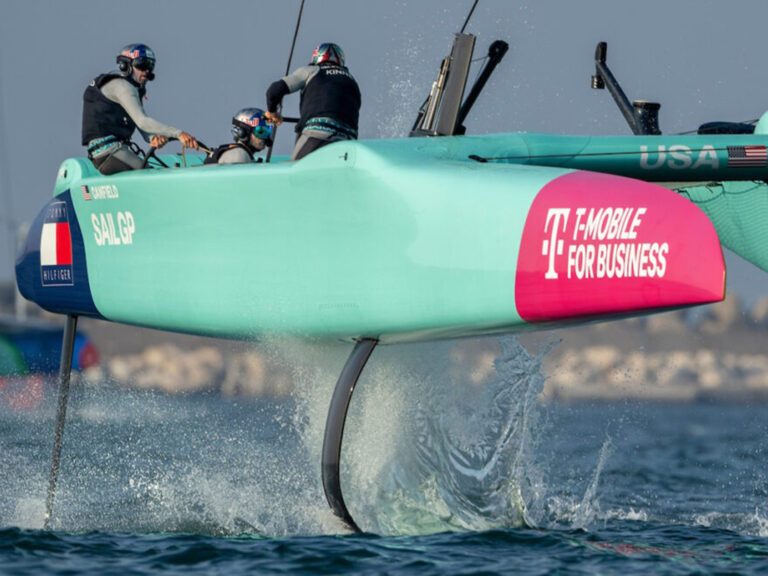In June 2005, for the third time in four years, Bryan Lake and Jennifer Warnock won A division at the InterCollegiate Sailing Association/Gill Coed Dinghy Championship. Each regatta was sailed in Club Juniors, but locations changed from Hawaii in 2002, Cascade Locks, Oregon, in 2004, and Austin, Texas in 2005. In 2004, Lake and Warnock and their University of Hawaii teammates won the championship as well. This year, the Rainbows led after the first day of sailing, slipped to third on Day 2, and then rebounded for a second-place finish overall on the final day of the regatta. Lake and Warnock, both from San Diego, started racing together as junior sailors and while many college teams will change crews depending on wind strength, this pair only raced with each other.What do you do during the pre-start to position yourself for a good start?Brian: I check to see which end of the line is favored before or during the sequence. Then I try to make sure I am on the favored side and that I have clear air on the start. It’s pretty simple really, but you have to make sure you don’t get bad air at the line.Jennifer: Before the sequence, I stand up in the boat and look upwind to see where the next puff is. I look around, ask Brian what he thinks he wants to do, and make sure we’re on the same page.How do you assess what’s happening on the first beat and react?Brian: I try to make sure I’m in phase and going fast. I check to see if the fleet splits off to two sides and make sure that the wind is on my side. If not I’ll probably get out and find better air. I just try to make sure that I’m in phase and that way, hopefully, I’ll at least be in the race.Jennifer: I’m constantly counting down puffs, and making sure we’re flat and fast.What do you say to each other when you’re racing?Jennifer: It’s really all about going fast. I generally leave the actual tactics up to him. I just let him know if there’s wind coming from one side, or if we’re being headed. I’ll tell him so he doesn’t go out to the wrong corner.Brian: Jen’s really good at that. She’s always telling me where other boats are and she tells me when she sees shifts. Even if I miss a shift she’ll be like, “Hey, shouldn’t you tack?” She’s always chirping in my ear about what’s going on, which is very helpful.Sailing with each other for such a long time must really be an advantage; what makes you two a good team?Brian: The communication is definitely good between us. We work together really well, and that helps us. It takes two to win.Jennifer: I think we both have the same sailing style. We both grew up sailing against each other; we both had the same kinds of coaches. His brother was actually my coach at one point. Our style just kind of clicked. We understand each other, we know what each other is going to do in the boat.The winds were fairly heavy during the championships; how were the controls set for your FJ for the heavy air?Jennifer: The outhaul is super tight and the downhaul is cranked on. I actually put my foot on the mast and yanked on the downhaul to get it tight. It can never be too tight in heavy wind. If it’s cranking out you can just stand on that thing and jump up and down to get it on tight. Brian: It’s pretty simple for heavy air. I just flatten out the main and flatten out the jib-lots of downhaul, lots of vang, and lots of outhaul.What about light air?Jennifer: Whenever it starts to lighten up it’s my job to make sure I let off the vang, downhaul, and outhaul. I just let it off for really light air, but if it only lightens up a little I kind of play it and make sure I tighten everything back up if it gets heavy again.What are the most important steps to a quick roll tack? Jennifer: Rolling together is most important. I think you really need to follow your skipper’s lead as a crew. If you don’t roll together it throws everything off and it will actually stall the boat. We used to talk it through, but we’ve been sailing together for so long that I just watch him and follow his lead. When he throws his shoulders out of the boat for the roll I go with him. We used to race each other across the boat.Brian: We make sure we’re in sync with each other and rolling together. And it’s really important for the crew to pull the boat over with the jib sheet. If you’re the crew, you want to try to rip the block off when you’re rolling.What should your sail trim be before and after? Brian: It’s pretty tight going into the tack, it’s trimmed all the way. After the tack, I let out maybe 2 to 3 feet of main in the tack and Jen lets out her sail. Then you pull it in again as you flatten the boat.Jennifer: It’s tight going in, but I don’t pull the jib in on the new tack until Brian pulls the main in, or it’ll stall the boat.What do you do differently when rolling in light air?Brian: We’re kind of a big team so sometimes we go a little over flat after the tack if it’s light. But we try to make sure the boat is flat after.Jennifer: I don’t throw my body completely down to the leeward side. I think that’s slow. If you throw yourself down to the leeward side you’re going to throw yourself into the jib, with all the wind coming into the jib. But I do a quick flatten and then hop right back into the boat.How can you tell if the jib is trimmed correctly on a run? Jennifer: I use the telltales, and I make sure the clew is out as far as possible. I try to keep it flat, without a lot of curl.What are you looking for when you choose your angles downwind and when you jibe? Brian: Clear air! It’s so important to have clear air when you go around the mark, especially when you’re racing in a big fleet. You have to pay attention before you round the mark. If there’s a puff coming from the right side of the course, say I’m on starboard and in a big right shift, I’m definitely going to jibe around the mark to get to that air.How do you manage mistakes on the water, such as having to sail through bad air off the start?Brian: You have to stay focused and try to find any lane you can. Sometimes I’ll foot to get out of bad air, but I really try to keep the boat going as fast as I can and not get stuck. You have to always stay positive. You can’t get down on each other.Where do you put your weight downwind and how are you helping to keep the boat fast?Jennifer: Well, because Brian’s so big, I put my hip on the leeward side to keep the boat flat; I never really stand up in the boat like a lot of other crews do.What drills, specifically, that you guys do have you found most useful? Brian: Sailing rudderless is really helpful. We’ve gotten pretty good at that, and it really helps your boathandling. We do a lot of tacking drills and a lot of short-course stuff. It gets really clustered at the mark. I think the best drill is just team racing, because you always need boathandling when you’re team racing so it’s good practice.Jennifer: I like one start drill that I was doing as a skipper, where the coach puts five people on the port side of the starting line and five people on the starboard side and you have to try to win the pin or win the boat.If there were a singular thing that you could tell FJ sailors to help them sail faster, what would that be?Brian: Stay positive and focused and always have fun. Everyone’s sailing the same boat, so you’re all going to be going almost the same speed depending on the shifts. But when people get down on themselves and think they’re slow, they go slow. But when you think you’re fast, it really helps you go fast.









